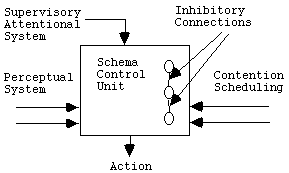
<<Back to Quiz Guide Summary Page
<<Back to Cognition Class Home Page
---------------------------------------------------------------------------------------
Quiz 3NAME:____________________________________ ID#:_________________
1. Describe the spatial cueing paradigm. What are the typical results? Which brain region is strongly involved in spatial orienting of attention?

In the spatial cueing task, subjects are given information as to where in space/location the stimulus will be (this is the valid condition). Even though ss can not move their eyes, they can covertly orient their attention. The results show the fastest response time for the valid trial and the slowest response time for the invalid trials.
The parietal cortex is involved in spatial orienting of attention.
___________________________________________________________________
2. What is the difference between late and early selection models of attention? Which codes are activated before selection according to Broadbent's model? Which codes are activated before selection according to Norman's model?
Both structural models of attention, early and late selection models differ in where the "bottleneck" occurs in the processing system. Early models place it at the level of sensory stores. Broadbent's model shows the activation of visual or auditory codes relating to the physical aspects of the stimulus. In contrast, late selection models place the bottleneck after extensive procesing and the representation of the stimuli remain in the sensory store whether selected or not. Norman's model bases selection on pertinence value that activates semantic codes and "decides" whether or not to select based on the "value" of the stimuli.
___________________________________________________________________
3. Describe the dual task paradigm. What are the main results of this paradigm? Why do those results invalid Kahneman's single capacity model?
The dual task paradigm involves experiments in which subjects must try to do two things at once. The purpose is to analyze how well subjects can perform on the secondary task to determine how much of the "resource pool" was taken up by the primary task. Results of this paradigm do not seem to point to a single capacity model because depending on the similarity of the tasks, the secondary task's performance fluctuates. Similar tasks seem to rely on the same "pool", but differing tasks seem to be able to use resources from different "pools".
4. Describe the Wisconsin Card Sorting Task. Why do frontal lobe patients have trouble with this task?
The Wisconsin Card Sorting Task is one in which subjects ar asked to sort cards that can vary along three dimensions. The cards are sorted by an experimenter-determined rule that changes after 10 correct responses withough the subject's knowledge. The cards must then be sorted according to that new rule until 10 correct responses are reached, at which time the rule changes again.
Frontal lobe patients have problems with this task because they cannot discard previously reinforced hypotheses for new ones. The old rules persevere.
___________________________________________________________________
5. Describe Norman and Shallice's model of goal-oriented behavior. Which are the situations in which the supervisory attentional system needs to be activated?

Perceptual system and schema control unit are linked to each other (this is connected to learning).
Contention scheduling:
When two imputs are mutually exclusive, they compete with each other. By having inhibitory connections in schema control unit, only one scheme can survive in that competition.
Supervisory Attentional System
Give flexibility in response to the selection system. SAS is activated when 1) incorrect resposes are likely to occur under the normal contention scheduling; 2) there is a lack of routine processes to get and appropriate response.
___________________________________________________________________
**Extra credit question**
6. What is visual neglect? Which brain region is lesioned in these patients?
Visual neglect: deficit in attentional orienting. Patients with parietal lesions have a hard time orienting attention to locations contralateral to the lesion.
---------------------------------------------------------------------------------------